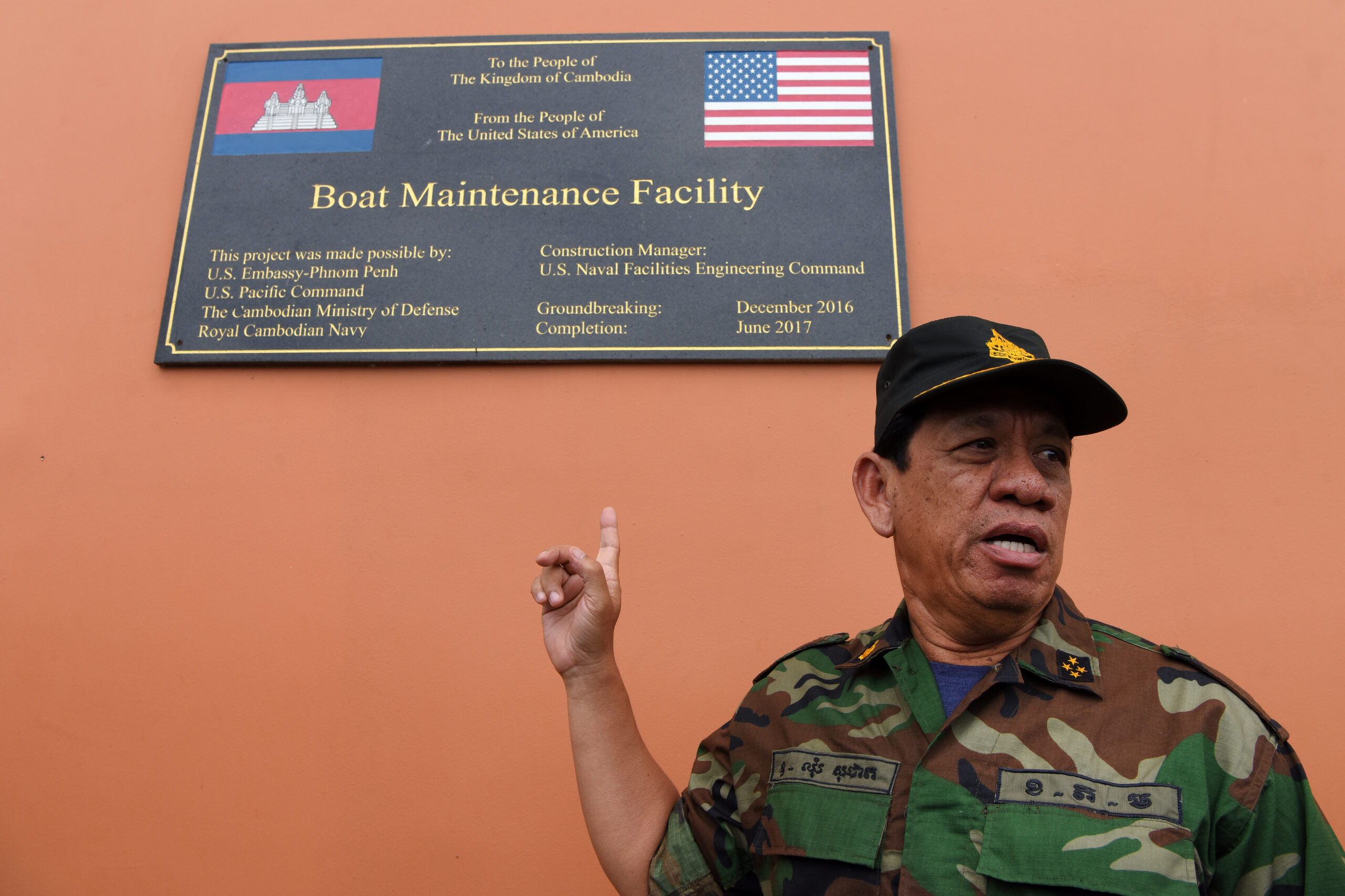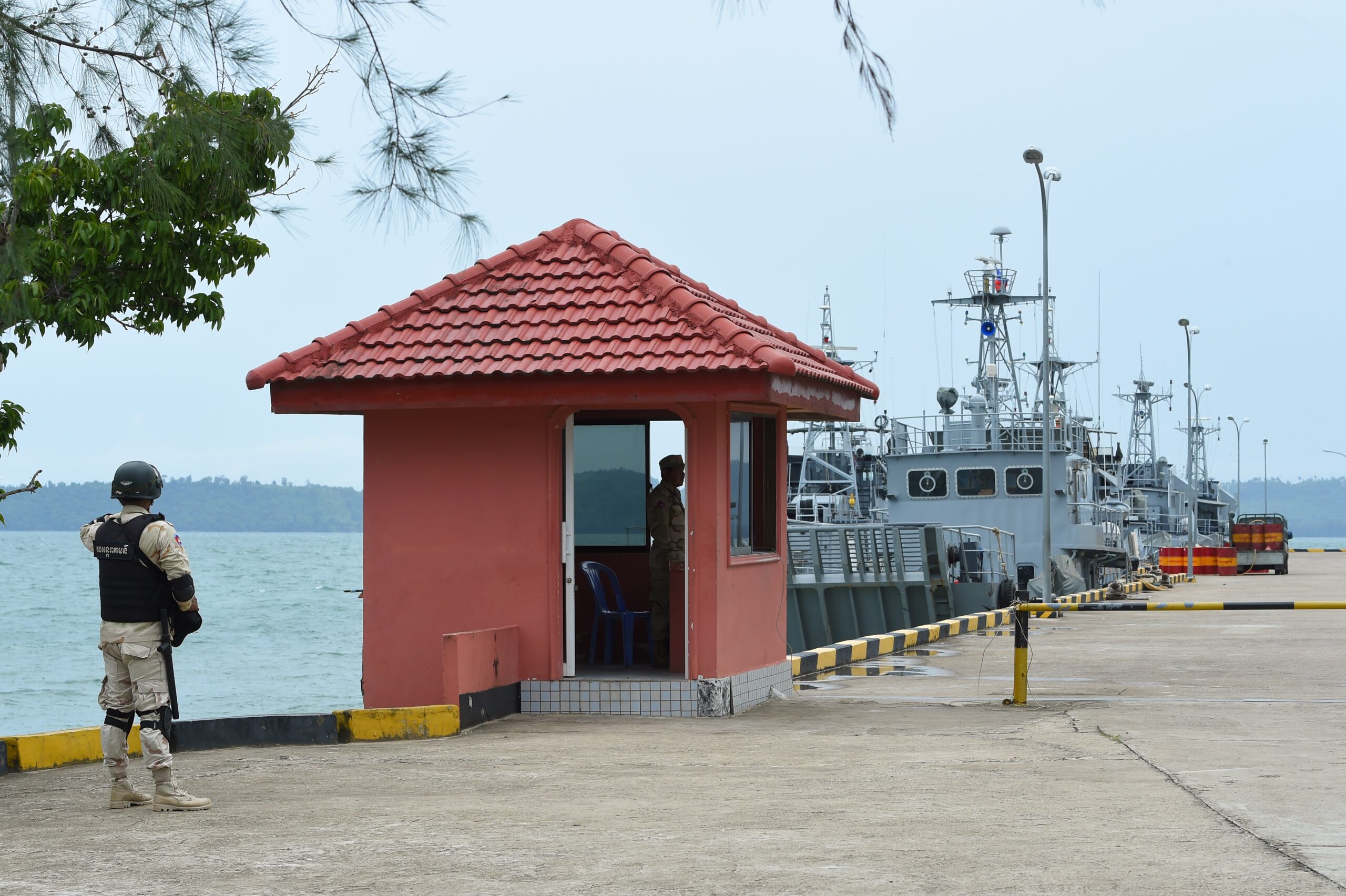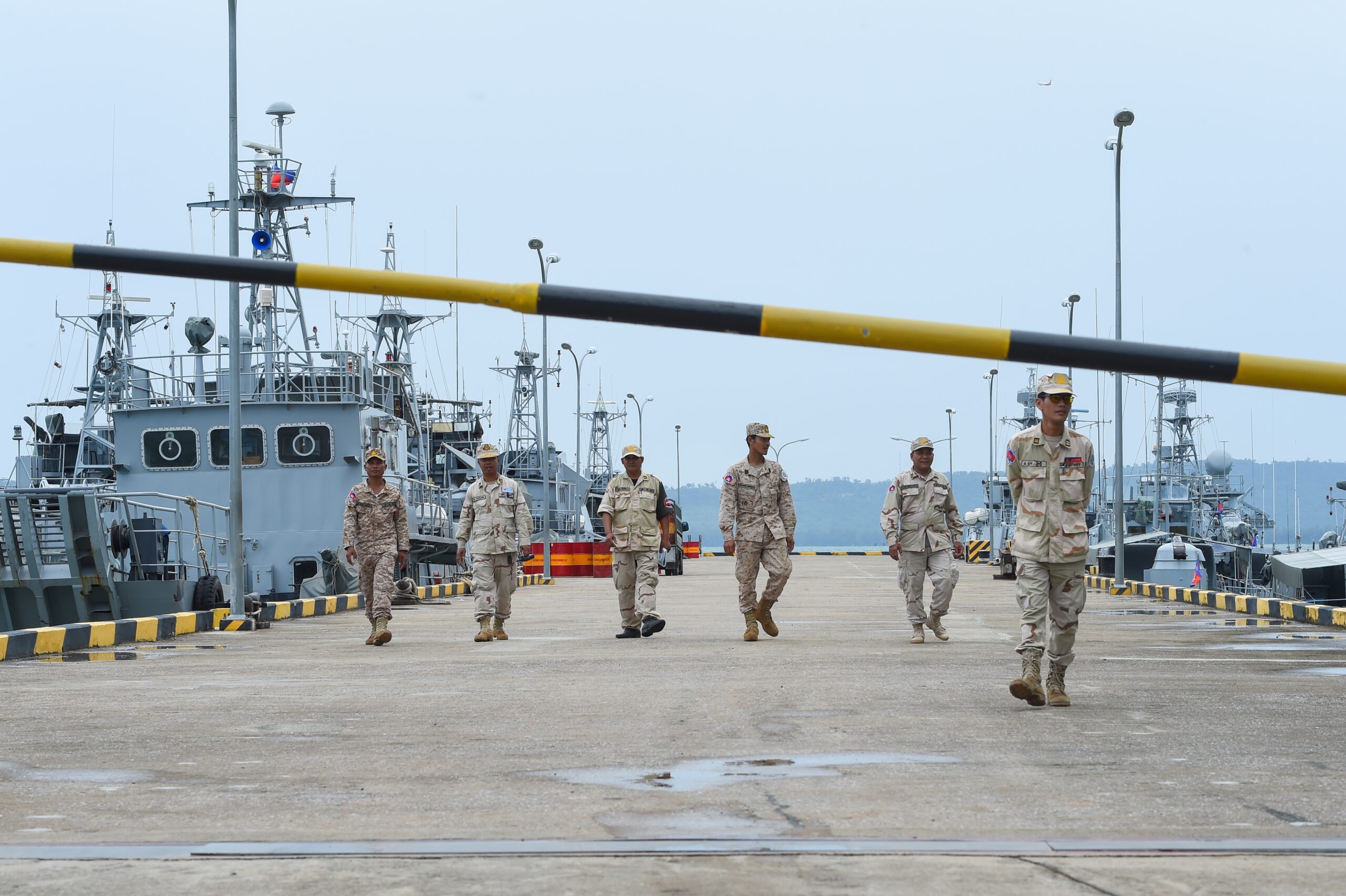Ream is located far beyond the power centres of Washington, D.C., and Beijing and hours from Phnom Penh. Yet the map point on the Cambodian coastline has become an active component in an ongoing strategic contest between the United States and China.
The U.S. has repeatedly signalled concern as satellite images appear to indicate Cambodia is expanding Ream Naval Base with help from China.
The American government recently imposed an arms embargo and expanded export restrictions on Cambodia. In addition to increased military ties with China, the U.S. additionally cited human rights concerns in Cambodia as reasoning for the restrictions.
The rumoured base expansion first gained attention in mainstream Western media in July 2018, when the Wall Street Journal published an article titled, “Deal for Naval Outpost in Cambodia Furthers China’s Quest for Military Network.”
China has a limited number of overseas military bases. The first opened in 2017 in the East African country Djibouti.
At the time of this construction, Professor Jin Yinan, an influential Chinese defence adviser, addressed a forum in Hong Kong about the departure from previous Chinese policy of avoiding building overseas military. “Will China copy the U.S. to seek hegemony in the world? No. We have to protect the Chinese maritime interest faraway,” Yinan said.
Yet public comments by American officials show they view the possible Chinese military presence in Cambodia very differently than simply protecting commercial maritime interests.
Throughout 2021, the U.S. repeatedly pronounced reservations about developments at Ream Naval Base, on Cambodia’s southwestern coast along the Gulf of Thailand. Senior diplomat Wendy Sherman expressed “serious concerns” during a meeting with Cambodia’s Prime Minister Hun Sen. The U.S. later accused Cambodia of not being transparent about construction on the base.
The U.S. allegations of Chinese-Cambodian collaboration on the Ream Naval Base have implications not only for Cambodia but also for its neighbours and broader U.S. policy in the Pacific.
A Chinese-controlled naval base in Cambodia presents no threat to America’s immediate interests. The Overseas Coastal Area Development Institute of Japan issued a 2012 report on the nearby Sihanoukville Port that found the waters in the Bay of Kampong Som are only 5 to 10 metres (16 to 33 feet) deep, which is not enough for submarines and other powerful naval elements.
Rather than a genuine fear of one potential overseas naval base in Cambodia, the U.S. is concerned about deepening ties between Cambodia and China and Chinese soft power in the region. American officials fear China could use these strategies to extend its overseas military capabilities in Cambodia or elsewhere.
“[Even] if it’s anything short of military basing, and would thereby involve access to Ream for the PLA Navy for example, it still amounts to concern [for the U.S.] about whether this could one day be graduated to a military basing arrangement,” said Collin Koh Swee Lean, U.S. programme coordinator at the Institute of Defence and Strategic Studies.
Unlike Cambodia, neighbouring Vietnam and Thailand do not have close military ties to China. Vietnam and the U.S. have grown closer and deepened their military ties during the last five years.
Cambodia is charting a different course, not afraid to be seen working closely with its Chinese allies.
In turn, the U.S. has levied economic and military sanctions against Cambodia, a punitive move rather than diplomacy despite Cambodia’s ascension to ASEAN chair in 2022. Overall, the U.S. strategy to promote democracy has not been well received in Beijing or Phnom Penh.
Future U.S. Strategy

The American arms embargo against Cambodia signals the administration of President Joe Biden will continue a standoffish approach to Cambodia. This is largely a continuation of American foreign policy towards Cambodia after the Trump administration levelled targeted sanctions against Cambodian officials and increased deportations of Cambodians.
The Biden administration has sought to mend ties in Southeast Asia after the Trump presidency, but the White House’s actions seem to favour punishment over attempted rapprochement with Cambodia due to the country’s increased ties with China.
“While the Biden administration is seeking to enhance engagement with Southeast Asia, in a style different from that of Trump, one may ask whether a second-term Trump administration might have done the same to Cambodia,” Swee Lean said.
Meanwhile, Cambodia’s neighbours Vietnam and Thailand have been wary of being seen to choose sides between China and the U.S., although they maintain a much closer relationship with the U.S.
In August 2021, the White House detailed the increased ties between Vietnam and the U.S. The statement mentioned enhancing Vietnam’s maritime security and increasing the Coast Guard partnership between the countries.
However, as Swee Lean emphasised, choosing sides between the U.S. and China has become a “dirty word” for ASEAN countries.
“When ASEAN countries profess ‘not choosing sides’ what they actually mean is that they won’t choose to go with one party on a slate of every issue,” Swee Lean said.
The Ream Naval Base represents a U.S. attempt to “persuade, through coercion or enticement, Cambodia to refrain from crossing the line into allowing military basing for China,” Swee Lean said.
There is no consensus among foreign experts about categorising the Biden administration’s strategy.
“I don’t think [U.S. foreign policy] is either engagement or coercion regarding Cambodia,” said Joshua Kurlantzick, a senior fellow for Southeast Asia at the Council on Foreign Relations.
Kurlantzick instead emphasised accusations of human rights abuses against the Cambodian military and government: “I don’t think an arms embargo when the country and the military are involved in rights abuses is exactly coercion.”
Regardless of strategic classification, the sanctions and arms embargo against Cambodia are a piece in the arsenal of U.S. power seeking to exert influence on Cambodia.
Conversely, China is Cambodia’s most important economic partner, in part due to increasing infrastructure investments such as the Ream Naval Base and China’s global Belt and Road Initiative (BRI).

Countering the Belt and Road
In June 2021, the G7 announced the Build Back Better World (B3W), an explicit attempt to counter China’s now 9-year-old BRI. A White House statement said, “B3W will collectively catalyse hundreds of billions of dollars of infrastructure investment for low- and middle-income countries in the coming years.”
While the BRI focuses on physical infrastructure, B3W zeroes in on health and other human infrastructure. China’s ambitions separate from the BRI include similar areas: the Health Silk Road, Digital Silk Road and Green Silk Road.
“[B3W] couldn’t possibly match new Chinese lending,” Kurlantzick said. “There is a component of the idea that is designed to match China, but more to show that the U.S. has not abandoned support for infrastructure [rather] than to specifically try to match China.”
The competing infrastructure plans may seem like an exercise in branding, but they are some of the more public battles between China and the U.S..
The U.S. is unmatched militarily, with 750 overseas military bases, while China has struggled to get much off the ground. Yet China’s emphasis on soft power through initiatives like the BRI has helped increase its international standing.
In Cambodia, this manifests in an influence battle between China and the U.S., and the U.S. perceives projects like Ream Naval Base construction as an affront to its regional military superiority.
China realistically has much more influence, according to Kurlantzick: “In Cambodia, China is more than the dominant trading partner; it is the dominant donor, key strategic partner, etc. I don’t think that’s likely to change.”
But the U.S. will continue working to maintain military superiority, including with sanctions against Cambodia. However, this may not preclude a return to a more amicable relationship between the countries. Cambodia holds the 2022 ASEAN chairmanship and the U.S. may find advantages in using incentives over punishments.
Kurlantzick said he believes that may not be enough, despite U.S. efforts at comity due to Cambodia’s ASEAN chair: “I would expect the relationship to continue to deteriorate between the U.S. and Cambodia.”
The U.S. mixed strategy toward Cambodia is visible in the administration’s public comments and in influential American foreign policy think tanks.
The Wilson Center, partially funded by the U.S. government, described U.S.policy toward Cambodia as the “Phnom Penh Dilemma” in a paper written by Lucas Myers, Southeast Asia programme coordinator.
I would expect the relationship to continue to deteriorate between the U.S. and Cambodia.”
Joshua Kurlantzick, senior fellow for Southeast Asia at the Council on Foreign Relations
The U.S. has two strategic options, “engagement” and “sidelining,” according to Myers, who said sidelining is more in line with the country’s current path and is therefore easier, although not without problems.
“Neither option constitutes a panacea to the dilemma of U.S.-Cambodia relations,” Myers wrote.
Engaging with Cambodia or attempting to sideline the Cambodian president as the country heads ASEAN present difficulties. China has made immense headway in strengthening the two countries’ bonds and the U.S. lags behind on infrastructure projects and foreign investment in Cambodia.
Derek Grossman, a Rand Corporation senior defence analyst, wrote that making Cambodian inroads “would take strategic competition into China’s own backyard.” He advocated countering China’s BRI and improving American access to the Ream base. RAND is a U.S. armed forces advisor with partial funding from the American government.
Future Forum Fellow Chen Heang said the U.S. has not established a clear goal or long-term strategy with the Cambodian government. “The White House has never invited Hun Sen’s government to pay an official visit bilaterally and vice versa,” he said.
There are likely to be continued mixed signals from Washington as the U.S. attempts to counter Beijing’s influence in Phnom Penh, Heang said.
“I think the U.S. would rather work with their selected partners to counter China. Thus, the U.S. will continue voicing concern about Cambodia’s government while working with their strategic partners to counter China,” Heang said.
Instead of a sea change in the region, the Ream Naval Base is likely to continue a longstanding disagreement between the U.S. and Cambodia.
”Changing Cambodia’s position or making an impact on Cambodia is essential but unnecessary in U.S. foreign policy,” Heang said.
Alec Pronk is a freelance journalist covering U.S. foreign policy. He holds a master’s degree in political science from the Leiden University.


